What happened to housing and financial markets over the last decade? To find out, follow the money.
According to Yale Professor Robert Shiller’s data, the run-up and collapse of U.S. home prices over the last decade were without precedent over the previous century. Where did U.S. households get the money they needed to bid up house prices so high?
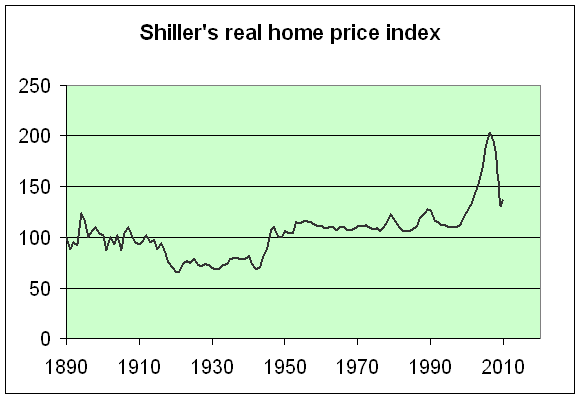 |
The answer is, they borrowed it, with household mortgage debt growing more than twice as fast as GDP between 1999 and 2006.
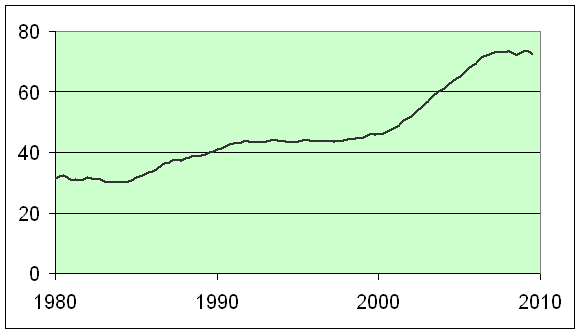 |
And where did the money come from that the institutions lent to U.S. households? The loan originators, who provided the initial mortgage loans, quickly sold them off to loan aggregators. In the 1980s these loan aggregators were primarily the government-sponsored enterprises Fannie Mae and Freddie Mac. But by the final days of the housing boom, the loan aggregators were more often private institutions who bundled the mortgages into asset-backed securities.
 |
OK, so where did the loan aggregators get the money with which they bought the mortgages from the loan originators? The GSEs took the majority of loans they purchased and collected them into securitized pools that were sold off to banks, pension funds, mutual funds, state and local governments, and buyers all around the world. What made these attractive to the buyers was the fact that the GSEs guaranteed the securities. Although Fannie and Freddie did not themselves remotely have sufficient capital to make such guarantees credible, investors thought– correctly, as events turned out– that if Fannie and Freddie ran out of cash, the federal government would step in to honor the guarantees.
Another good chunk of the loans that the GSEs purchased they ended up holding themselves. And where did the money for that come from? Again, it was borrowed. Investors willingly lent trillions of dollars to the GSEs at rates only slightly above that on U.S. Treasuries because lenders again believed that Uncle Sam would ensure that the GSE debt was repaid.
But most of the later egregious NINJA loans (no income, no job, no assets) were made by private loan aggregators. And where did they get the money? Again, much of it seems to have been borrowed. If you buy a mortgage-backed security (or collateralized debt obligation constructed from assorted MBS), you could then issue commercial paper against it to get most of your money back, essentially making the purchase self-financing. This was the idea behind the notorious off-balance sheet structured investment vehicles or conduits, which basically used money borrowed on the commercial paper market to buy various pieces of the mortgage securities created by the loan aggregators. The dollar value of outstanding asset-backed commercial paper nearly doubled between 2004 and 2007.
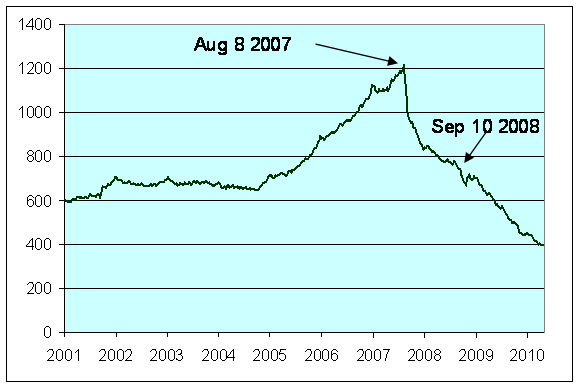 |
Yale Professor Gary Gorton has also emphasized the importance of repo operations involving mortgage-related securities. If I buy a security, I can then pledge it as collateral to obtain a repo loan, again getting most of my money back and allowing the purchase to be mostly self-financing as long as I keep rolling over repos. Although I have not been able to find numbers on the volume of such transactions, it appears to have been quite substantial.
The question of how the house price run-up was funded thus has a pretty clear answer: Other People’s Money. Because of so much money pouring into house purchases, the price was driven up. And because house prices continued to go up, the shaky quality of many of the underlying loans for a while did not come back to bite anybody. If the buyer makes a capital gain on the home purchase, there is every opportunity to refinance the loan and repay the original lender, no matter how poor the borrower’s initial financial condition. But after house prices began declining in 2006, the jig was up. The freeze of assets by BNP Paribas in August 2007 was followed by a sharp increase in the spread between the rate on asset-backed commercial paper and nonfinancial commercial paper.
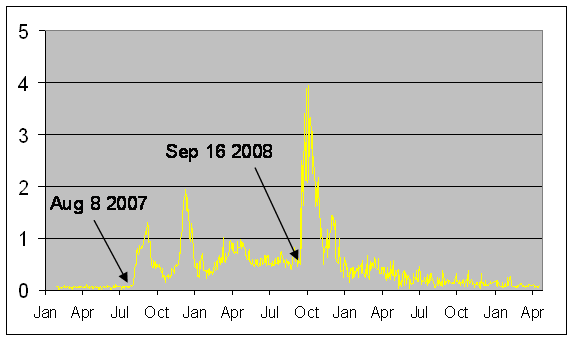 |
The haircut on structured-debt repo– the amount by which the value of collateral delivered must exceed the money lent against it– started to climb dramatically after August 2007, forcing repo positions to be unwound.
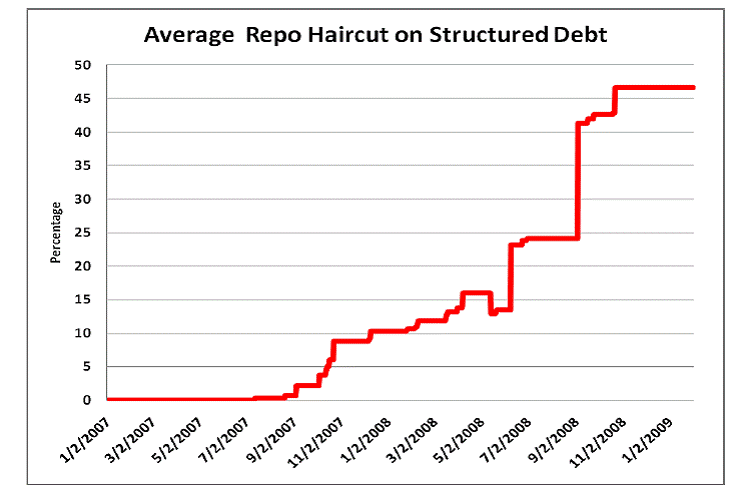 |
To the extent that purchases of mortgages were being ultimately being funded by short-term borrowing through commercial paper or repos, the institution borrowing in this manner was essentially fulfilling the function of a bank– borrowing short and lending long. If, as happened starting in 2007, those providing the short-run funds choose not to renew the loans, the institution would be forced to liquidate its long positions in a market where the underlying securities could only be sold at a deep loss. In other words, there would be a run on the shadow banking system.
Now, there are two aspects of the situation that began in August 2007 that one might choose to emphasize. The first perspective supposes that self-fulfilling fear itself is the key dynamic that propagates the crisis, as fire-sale prices create ever-spreading losses. When calm and rational valuation return, all will be well. The key problem, according to this perspective, is that would-be short-term lenders were hit in August 2007 with a sudden irrational lack of exuberance that ended up persisting over a year and bringing much of the world economy down with it.
The other perspective of what happened beginning in 2007 is that those Other People— the ones who ultimately provided the Money that drove all this– finally started to wise up.
Presumably a steady sequence of federal reserve rate overnight rate hikes increased the cost of speculative borrowing and fits with this notion that the ultimate lenders started to wise up. Another interpretation of events is that ultimate lenders saw the yield curve flatten and turn negative, and then decided to rebalance portfolios in light of an anticipated recession.
This is like staring at the road map to a horrendous automobile crash. Strikes me that the credit-fueled boom started to fizzle in summer 2007 but didn’t really crash until late summer 2008. Gets one thinking about monetary policy lags. Two years, even more, is not extreme.
What happened in ’05-’07 was that the cumulative differential rate of growth of wages and M2/bank loans/debt from the late 1960s and early 1970s (US oil production peak and onset of the “limits to growth”) reached the critical order of exponential magnitude, i.e., the “Jubilee threshold”, requiring debt-money growth to be faster than exponential to keep debt service and so-called “growth” going.
Of course, once the Jubilee threshold is reached, diminishing returns to debt expansions results in the inability of firms and labor to sustain investment, production, and debt service sufficient to sustain the existing debt, let alone service still more debt at compounding interest.
The Jubilee threshold has been forgotten (never learned or not taught) by post-modernists (“end of history” bunch) neo-Keynesians and the economics profession; however, it was well established by the ancients from the Sumerians, Babylonians, Persians, and Hebrews, to name just a few. Growth of debt and its service cannot exceed labor product or production longer than the extent to which the debt becomes unservicable at a given term.
For example, $1 lent for a perpetual term of, say, 30 years must include a subsequent growth of debt of more than ~2.6%/yr. over production or labor perpetually just to ensure the existing debt can be serviced. Grow debt (credit-money “inflation”) at a faster sustained rate over labor and production, and the Jubilee threshold is reached before the 30-year term.
And it is not a coincidence that we achieved the Jubilee debt burden threshold at virtually precisely the point at which global oil production (extraction of finite reserves) occurred in ’05-’08.
Now we have gov’t taking over where the private banking system cannot continue to lend, having reached the Jubilee threshold. But neither can gov’t grow debt at a differential rate in excess of output before the public debt Jubilee is reached. Since ’00, US nominal GDP has averaged just 3.96%, which is less than the 60% of the long-term trend of ~7%. However, gov’t is growing borrowing and spending at more than twice the rate of GDP, implying that the public debt Jubilee threshold date is awaiting us in ’16-’18 at the given trend of gov’t spending and GDP.
Not coincidentally, ’16-’18 is when China’s oil consumption will converge with US oil imports, with the projected date for US and China oil consumption parity in the early ’20s. At that point, in addition to approaching US and EU fiscal insolvency, we will be in direct competition with the Middle Kingdom for dwindling global oil reserves, with OPEC exports falling and China running a persistent trade deficit for oil and food.
In fact, Japan has de facto reached the Jubilee threshold for public debt after reaching the same point for private debt in ’97-’98. Japan is the canary in the proverbial mine shaft for the US and EU WRT debt/GDP. What happens to Japan will very likely occur for the US and EU 7-10 years hence (and sooner for Greece, Portugal, Ireland, Italy, easter Europe, and the UK).
Nemesis
Ya, James mon. Sounds like it. We had the “wholesale bank run” that ended it. (Repos dryed up) It was low interest rates and the “search for yield” that got us “other people” to put our money there, like we had a choice. If you wanted to “stay on the sidelines”, the banks, and brokerages did it for you. No choice again.
And the system is still trying to force the same thing with ZIRP and QE. When will they finally acknowledge that economics as they know it is broken?
Great post. Especially this: “The other perspective of what happened beginning in 2007 is that those Other People– the ones who ultimately provided the Money that drove all this– finally started to wise up.”
Right. I don’t think there was a “panic”, but a massive repricing which was entirely consistent with what reasonable people thought the “true” market value of the assets really was. In Gorton’s piece, which you cite, the prices dipped almost 50%, which sounds about right since everyone knew the underlying collateral was suspect.
Of course, Bernanke still clings to the idea that these are just “unloved” assets that will eventually bounce back. But what else can he say: “We’re going to mark these turkeys down to their real value and shove the banking system off a cliff?”
He’s just doing his job, which is fine, but cooler heads need to demand that the shadow banks are strictly regulated from here-on-out so we don’t end up in the same pickle two years from now.
Keep following the money!
Where did all the money from Money Market/Repo/Shadow banking come from, and where did it go?
I would say that the rapid expansion of 1st world productivity to 3rd world labor caused productivity to rise faster than wages globally, creating the supply of capital. Government risk (mis)regulation directed that supply into securitized debt markets, creating the housing bubble (Stocks could not be securitized into AAA rated securities). It went into government bonds, forcing the fed/treasury to regurgitate it back into the housing market/bailouts.
WRT ‘other people’s money’ — Money market mutual funds filled this role by buying much of the short term debt. Once the short term market became illiquid they broke the buck. With no short term source of funds, the entire MBS business model collapsed. Bernanke and Paulson warned the government that we were on the verge of a global meltdown and the big investment banks accepted the government cramdown.
The investment banking business model collapsed and Lehman ‘was allowed’ to fail while the others morphed into commercial banks.
Fast forward to today. The FED has replaced money market mututal funds as the source of shrot term funds in the MBS game, now controlled by Fannnie and Freddie, (with government support). Fannie and Freddie have expanded in scope and continue to operate using a broken business model.
“But most of the later egregious NINJA loans (no income, no job, no assets) were made by private loan aggregators. And where did they get the money? Again, much of it seems to have been borrowed. If you buy a mortgage-backed security (or collateralized debt obligation constructed from assorted MBS), you could then issue commercial paper against it to get most of your money back, essentially making the purchase self-financing. This was the idea behind the notorious off-balance sheet structured investment vehicles or conduits, which basically used money borrowed on the commercial paper market to buy various pieces of the mortgage securities created by the loan aggregators. The dollar value of outstanding asset-backed commercial paper nearly doubled between 2004 and 2007.”
It should be pointed out that this investment is very dubious on its face. In essence, you’re competing against a subsidized competitor without the subsidy. Why is there a subsidy? Why are there GSEs? To loan money to people who private lenders wouldn’t lend to. So, in the end, you had lenders lending to people who the private sector wouldn’t lend, that needed a subsidy to incentivize lending to them, without the subsidy.
As well, you had lenders lending to people who had the most problems paying their loans at the top of a market. Nothing makes either of these moves prudent. How risky they are is a matter of opinion, or used to be rather.
I have trouble believing it was all due to what was a $700B trade deficit in the peak years being re-cycled back into a $15 trillion US economy.
I think one of the flaws in the analysis is the focus on “flows”, and ignoring “stock” of the $60 trillion the US has in personal savings to invest. I think that is what the banks have their eye on.
On following the money
Were the credits making the deposits? Money multiplier at work isn it ?
http://research.stlouisfed.org/fred2/series/GSAVE
savings deposits
http://research.stlouisfed.org/fred2/series/PSAVERT
Bank credit of all commercial banks (see vintage MAX http://alfred.stlouisfed.org/series?seid=TOTBKCR&cid=101)
Assets at Banks whose ALLL exceeds their Nonperforming Loans
http://research.stlouisfed.org/fred2/series/LLRNPT?cid=93
In transition total consumers loans and credit were at 125% of GDP in the US 100% of GDP in Europe,total loans and credit outstanding at 340 % to GDP against 260% of GDP in 1935.
Banks assets needed a little help in funding and ultimately states found a little help from central banks P9 (swaps between central banks are off balance sheets)
Taking stock:
where do we stand in the crisis?
Jrgen Stark
Member of the Executive Board
and the Governing Council of the European Central Bank
Slides for the speech delivered at
BMW Stiftung Herbert Quandt,
Washington D.C., 15 April 2010
http://www.ecb.int/press/key/date/2010/html/sp100415_1_annex.en.pdf?60badb733409c42146d5e127e6389064
So far it was good, untill the markets found that Greece was not in compliance with the treaty of the Union.
One may fear the reaction of the markets when they will find that banks liquidity ratios are not in compliance with Basle liquidity ratios, (the so called 105 repos is widely used for liquidity purpose as well) and that SIV or SPV are back in fashion.
Indeed a great post gents… I hadn’t seen the data on repo haircuts prior to this post, where the 0% haricuts for ’06 and ’07 rings true of the risk atmosphere back in those days. As if the levered money creation would keep coming forever.
This data is eerily reminiscent of the kinds of reports coming out of China more recently regarding the appetite for real estate risk in that country. I compiled some research on the topic of public finance in china and the systemic ties between real estate prices and off balance sheet operational financing of lower tiers of government.
From your extensive academic repertoire, do you fellas have any input on the housing situation in China, and how it may be similar/different to the U.S. market?
JDH: great post.
It makes me wonder whether it would be possible to build something like a real time power grid display that shows where there are troublespots in the financial system ex ante, as opposed to tracing through the detritus ex post. Obviously with so many OTC instruments it would be difficult, but it also seems that the inter-market channels of transmission are even more important than the activity in any particular market …
. . . plus a trillion or so pouring into the markets from China, Japan, oil exporters.
JDH wrote:
The other perspective of what happened beginning in 2007 is that those Other People– the ones who ultimately provided the Money that drove all this– finally started to wise up.
Professor,
Great job of pushing down to lower and lower sources of the problems but I do believe you stopped too soon. Just who were there “OTHER PEOPLE?” Now if the answer is China and Japan the thing that we have to understand is that China and Japan were not supplying yuan or yen. They were supplying dollars. So push back. Just where did they get their dollars?
It goes without saying, as most of the stuff I say does, but the conduits and special investment vehicles that used CP to purchase mortgage debt products were engaging in the classic yield curve grab. Banks do that on a restricted basis, with FDIC (or other) oversight, and still get into trouble. Allowing a new(ish) form of business to grow to very larger proportions for which the business plan was essentially to play the curve by taking on maturity and roll-over risk, without taking a serious look at the risks, was a big mistake. Yes, yes, we all know that now, but we have always known that. Borrowing short to lend long is what banks do. Banks are regulated because borrowing short to lend long involves inherent risks which have been understood for generations. But oh, dum-dee-dum, seeing all that happy money run and play just makes it hard to be responsible.
I’d like to see a further explanation in terms of base money (created by the Federal Reserve banks with Treasury debt as the offsetting asset), bank money (created by banks against assets such as houses and incomes) and shadow-bank money (created by vampire squids and backed by financial derivatives).
I would also like to see how proposed financial reform would result in the regulation of the shadow banking system.
Sigh.
Prof. Hamilton,
Isn’t it the role of central banks to limit the amount of lending by requiring banks to keep a percentage of the loans they create on deposit as reserves? What influence did the Basel regulations have on money creation by allowing banks to keep less money on deposit for loans that were bundled into off-balance securities?
An interesting book related to your post, James : http://press.princeton.edu/titles/8973.html
…before we start theorizing, lets take a hard look at what history tells us.
Qingdao
“. . plus a trillion or so pouring into the markets from China, Japan, oil exporters.”
That’s of course part of it, but the cum CA deficit was still much smaller than the total growth in just housing prices alone.
Now the domestic policies of China, Japan, and oil exporters have a lot to do with re-cycling surpluses back to the US. It was forced savings in China. In Japan they had ZIRP and QE, so as a trade surplus country they are a net saver and investment came to the US in search of yield. The oil exporters began much more internal spending of their surpluses, so this is one reason I think the dollar declined this decade, because they did not re-cycle all of them.
Now it’s also too simplistic to say it was the Fed “printing money”. They do that and can drop a boatload of it on the market to drive the Fed funds rate down (then do the opposite, when they desire). But the point of that is to influence the long term rate and cost of credit which is the primary tool in regulating the economy.
So we need something like what kharris mentioned above to come to any sort of analytical grip on whether the Fed can do their job or not, as stated. But instead it looks like we may get the Dodd Bill.
Good post, but incomplete.
First, we have a process of credit creation for mortgages, funded by issuing securities, CDO, in turn financed by commercial paper. But did this money and credit appear out of thin air? Why don’t we have exploding money and credit all the time? We need to anchor the process in the behavior of central banks. The Fed and other central banks pushed policy rates to record lows in the past decade, expanding money and credit.
Second, there is the matter of international imbalances. The US funded itself collectively by running record current account deficits, funded by OPEC and East Asian surpluses seeking good investments.
Third, expansion of mortgage credit boosts the demand for owner-occupied housing, but not housing collectively. Where is the supply side? It is curious how much we want to explain oil prices with the supply side (what about demand?) but we want to explain housing prices and starts with demand side (what about supply?). The Midwest and South had the same interest rates and financial access as the rest of the country but house price gains were reasonable. Supply-side made a difference.
Finally, the US was not the only country with surging house prices. To the contrary, we find bigger increases in Spain, UK, France, Ireland, Iceland, Spain, Denmark, Sweden, New Zealand, Australia, and perhaps China. Any explanation for the house price boom must account for the global boom. A US-centric explanation fails to give a unified account. Low interest rates is likely a key global factor.
B.B.
Housing prices went up the most where supply of land was constrained. Commuting times factor in to how far out to the desert someone in CA is willing to move. Traffic moves at 15mph during “rush hour” and rush hour is 3 hours long.
I just flew over Atlanta, and saw how urban sprawl there capped house price appreciation.
In Texas property taxes are 3%, so that puts a drag on the pocket book. Menzie can probably fill us in on WI property taxes.
As far as it being a global phenom, the suspects here would be central banks and clearly Basel 1 doesn’t work. Global financial instability also became the global norm. Our watchdogs/systematic risk regulators, the IMF, World Bank and BIS were either asleep or whatever small peeps they were making went ignored.
Then the new Dodd Bill seems to give everyone the same discretionary powers that they didn’t use before, so not much comfort there. (But what would we expect from a Senator from Connecticut)
Excellent post, Jim, one of the best.
The other interesting phenom is the housing boom in Australia hasn’t stopped yet, in spite of their CB moving short rates up. I read a blog comment from an Aussie and he said he was literally priced out of Melbourne and got a better paying job in the US and his mortgage here is far less as a percentage of income. He claims it is because the Aussie government used to disallow foreign ownership of residential property, but relaxed that and Chinese investment is coming in and driving up prices. He thinks it’s just a matter of time until the big Aussie banks go boom.
This is a good summary of the funds flows and prices that led to one of the great financial crisis ever.
But what about the word “fraud”? NINJA loans are mentioned, but not in connection to the rating agencies who were paid to put AAA quality ratings on the bundles. Nor is there mention of investment banks that sold synthetic leveraged bundles that were selected for their high probability for default – and didn’t reveal this in the offering material. And then there were banks that used “controlled child” companies to do Repo 105 transactions every month end to dress up their balance sheet. And then . . .
A history of the Mafia covering only bank accounts and prices paid to members over the same period would be viewed as sort of missing the major events of the organization.
Fantastic post! I appreciate the disaggregation of the excesses in real estate lending into the component parts.
Probably the main source of funds was the credit expansion itself. When a $200k home becomes a $300k home, $100k in money has been produced. If a sale, the borrower has to borrow an additional $100k, but the seller has made $100k to lend him. He may buy himself needing to borrow even more, but that just leaves that seller with even more. The Fed outsourced the printing presses to lenders to compete with each other in how much money they could print.
Lord,
You didn’t need to sell either. HEW gave you access to borrow the “gain”.
Jim: This insightful post belongs in ‘Fueling the Flames: the Expansion of Credit,’ Chapter 4 of Charles Kindleberger’s ‘Manias, Panics, and Crashes.’
FED must change the expectation of zero interest rate for too long period among investors, businessmen and consumers now because
1. Zero interest rate is not suitable for the current economy with the much higher-than-expected economic growth and the higher-than-expected inflation without house inflation effect. We have the higher GDP growth and all indicators point the overheating economy. The zero interest rate is suitable only in the depression-like economy. The depression is the sharp drop in economy and price but now we have the sharp rise in the economy and the higher inflation.
2. We have the job growth but the high unemployment is not because of the bad economic environment but because of the uncompetitiveness of international labor cost and capability. We are also going to the rising age-population; therefore, the early labor retirement will occur during this recession but there are many workers decide to stay along the sideline rather than find the full-time jobs. The structural change in technology also create the high unemployment that will take time to see the labor improvement but this effect cannot be affected by the interest rate.
3. Too low interest rate will create the wrong expectation and surely the crisis will come. First, the investors in financial markets will speculate too much and surely they will create bubble like subprime. The businessmen in Main Street will create speculative investment in inventory that will create the bubble in commodities. Finally, too long interest rate expectation will create bubble in bond market that we create the debt bubble in all borrowers including consumers, investors and entrepreneur as well as governments or there is the risk of too high government debts, which will create the all default crises in the future.
FED must change picture of expectation now by increasing the interest rate from zero band (0-0.25%) to 0.25% at first and must move rate to normalized level under monetary rule that is likely to stay at 3% at end-2010 if economic growth is still strong like this.
We should stop bubble by creating discipline from monetary and fiscal policies together.
The Senate is having the Calamari Roast on CNBC this morning.
The Goldman people are a bit tongue tied.
I just found out that ABACUS seems to be one of the places all those New Century loans ended up.
Very nice post.
The first graph appears to go to 2010, despite the subtitle.
Jim, let me add my compliments for a great post.
Several of the responses above ask about money creation, but I still don’t understand the analytical disconnect between asset inflation and consumer prices. In 2000-2006, the cost of a consumer good (housing) that represents 33% of typical annual family income was rising at about 7%, and CPI was only going up at 4%. How is that possible? It’s not as if incomes were growing.
Well, the asset purchase was financed with a growing amount of low-cost floating rate debt, so it seems to me the “balance sheet” effect didn’t translate into an “income statement” effect. Then, when ARMs started readjusting in 2006, the incipient balance sheet inflation finally turned into a cash cost for a rising portion of households, and the spike in energy prices in 1H 2008 was the nail in the coffin for consumers.
So does this mean CPI is a flawed measurement? Shouldn’t the Fed’s goal of price stability include an aggregate basket of asset prices? I know there’s a lot of debate out there about the Fed’s role in managing asset bubbles, but aren’t asset bubbles fundamentally connected to CPI and PPI, no matter how they are financed?